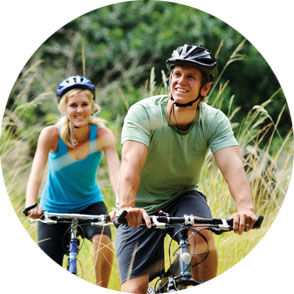
Defining Muscle Fatigue and Overuse
When we work our muscles, they build up lactic acid, a chemical compound that forms from broken down glucose and a substance called pyruvate. Lactic acid is the byproduct of metabolism and energy production. The body attempts to get rid of it as fast as it can, but when it builds up faster than the body can eliminate it, that’s called “hitting the wall.” Once you’ve reached your peak, the muscles you’re currently working become too overworked to continue, so your body must rely on others to compensate. Unfortunately, this eventually leads to the overexertion of all your muscle groups and puts you at risk for an overuse injury.
Bike Size and Fit
If you’re a new cyclist, one of the first things to consider is a proper bike fitting. You will be much more prone to injury if you’re uncomfortable on your bike. To find the right bike size, your height and weight will be taken into consideration at the shop before the more in-depth fitting begins. The purpose of bike fitting is to prevent injury while improving your efficiency and power, as cycling is an endurance sport. It is based on three parts of the bike: the saddle, handlebars and pedals.
- Saddle Position
First, you should select a bike with a comfortable, up-right seat so you’re not leaning too far forward or back. Then, determine the proper height so your knees aren’t hitting the handlebars as you pump. The best rule of thumb is to see how the saddle feels when your feet are on the pedals at the 3 o’clock position.
- Handlebars
Your handlebars are in the ideal position when your elbows are slightly bent, but you aren’t reaching forward. An improper amount of space between you and the handlebars can cause locked elbow issues, lower and upper back pain and neck pain from extending too far forward.
- Pedal Position
The bike fitter will likely want to see you pedaling to determine the proper position. With the pedal at 3 o’clock, your knee should be over the ball of your foot and bent at a 30-degree angle at the bottom of each revolution to avoid kneecap pain and hamstring issues from overextending the knee.
PT Exercise Program to Prevent Injury
If you experience an injury while cycling, a physical therapist can not only treat it, but teach you how to prevent a future flare-up. First, build up your flexibility through stretching. Many cyclists experience calf and knee injuries. We recommend standing calf stretches to work your soleus and gastrocnemius, two large muscles in the calf, and squats with only a 60-degree knee bend to reduce the risk of a patellar injury.
Second, every new cyclist should learn his or her physical limitations. Take a short ride around your neighborhood and stop when you’ve built up a sweat, slowly adding more distance each day. When you start to feel fatigued, you know exactly how far you’re able to push yourself before an injury occurs.
Additional Tips
If you’re out cycling with friends and you have a long way to go before you reach your destination, drift behind another cyclist to reduce wind resistance. Drifting cuts down wind resistance by 30 to 40 percent, so your legs don’t have to pump as hard!
Also, mix your H2O with Gatorade to hydrate and compensate for sugar loss which can lead to cramping.
Remember to also bring a snack for the road – anything that is easily broken down for fast energy. I like Clif Bars because they contain high amounts of sugar and carbs.

